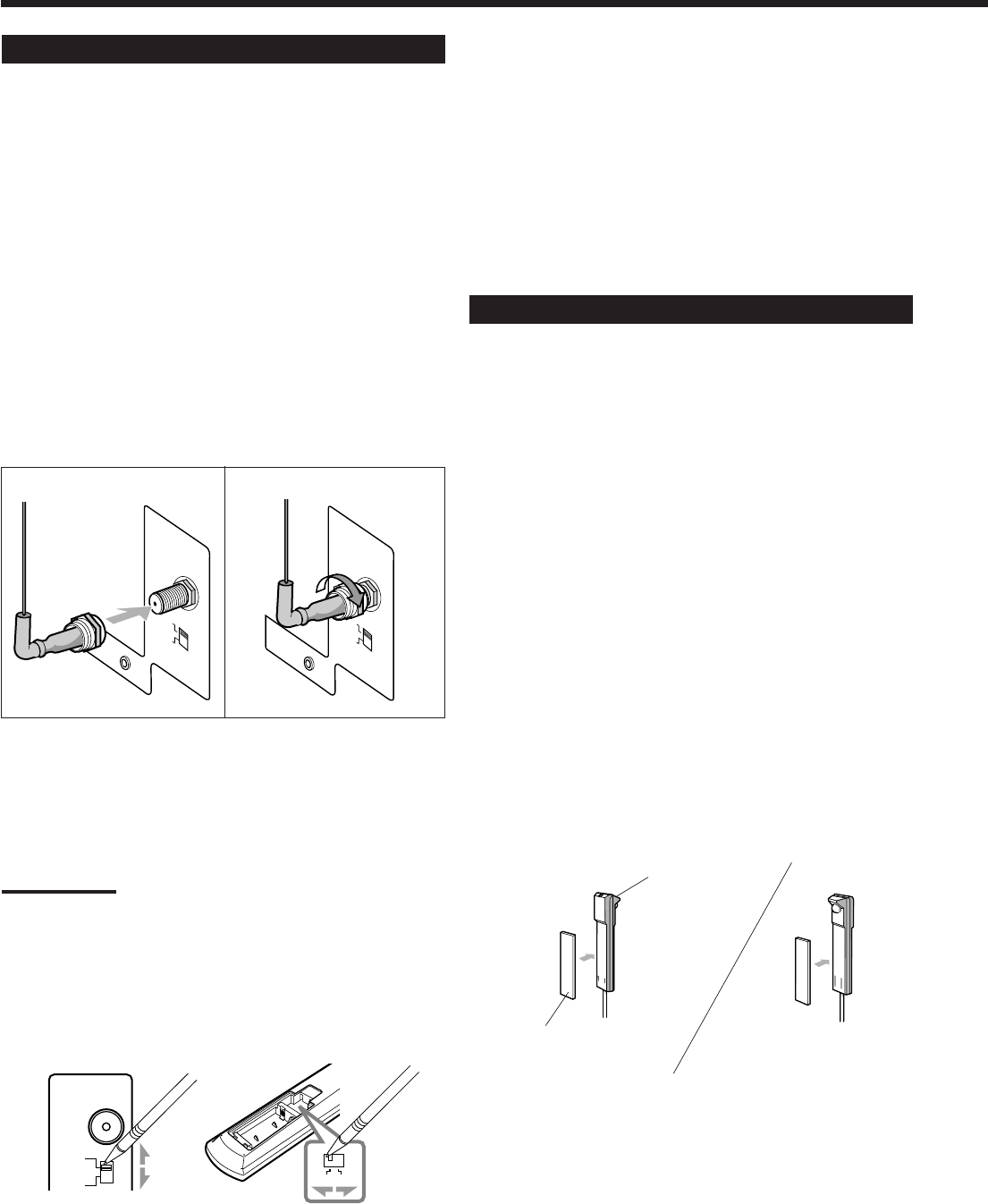
15
Setting Up the RF Rod Antenna
The remote control supplied for this receiver can transmit both RF
(Radio Frequency) signal as well as IR (infrared) signal. The RF
rod antenna can receive the RF signals emitted from the remote
control. So, with the RF rod antenna connected, you can operate the
receiver at a distance of up to 15 m (50 feet) using RF signals sent
from this receiver (more than twice as far as when using IR signals).
Moreover, RF signals can go through walls and other objects in the
house so you need not aim at the receiver directly.
However, if the antenna cannot receive signals stably, you cannot
operate the receiver correctly.
• The signal-reachable distance may differ depending on the
operating conditions and circumstances. To improve transmitting
conditions, change the distance to the receiver and the direction
to transmit while operating the remote control.
• Without the RF rod antenna connected, you can operate the
receiver with the remote control, aiming the remote control
directly at the remote sensor on the receiver.
To set up the RF rod antenna
1. Insert the RF rod antenna to the RF REMOTE
ANTENNA terminal.
2. Rotate the fixing nut to attach the RF rod
antenna firmly.
Notes:
• To avoid a failure in the reception from the remote control, keep the
connecting cables and the IR signal transmitter’ s cable away from
the RF rod antenna.
• If your neighbour uses the same or similar RF remote control
system, the receiver may happen to receive the RF signals sent
from such an RF remote control system, which could cause your
receiver to be operated unintentionally. If this happens, set the
BAND selectors (both on the rear and on the remote control) to
another band (either BAND 1 or BAND 2).
If the problem still persists, stop using the RF rod antenna and the
remote control, and consult your JVC dealer or the nearest JVC
Service Center.
The RF rod antenna and IR signal Transmitter
The combination of the RF rod antenna and the IR signal transmitter
(below) allows you to use the Multi-room function more
conveniently.
The remote control supplied for this receiver can transmit both RF
signal and IR signal at the same time. This receiver catches the RF
signals emitted from the remote control, and converts them into IR
signals, then transmits the converted signals to the remote sensor on
the other components through IR signal transmitter.
This means that you can control not only this receiver but also the
other components from the sub-room.
Setting Up the IR Signal Transmitter
The IR signal transmitter can transmit the IR signals.
It allows you to use the AV COMPU LINK system, and to operate
other manufacturers’ components without aiming the remote control
directly at the remote sensor on the target components. In addition,
the IR signal transmitter reduces the possibility of malfunction.
• The IR signal transmitter may not operate the target components
depending on the operating conditions and circumstances—
including the aiming angle and direction of the IR signal
transmitter at the remote sensors of the target components. If
this occurs, changing its aiming angle and direction at the
remote sensors may solve the problem.
To set up the IR signal transmitter
1. Find the place where you attach the IR signal
transmitter.
• Place it where the signal can reach the remote sensor of the
target components directly (in the line-of-sight).
• If the cord length of the IR signal transmitter is not long
enough, use an extension cord (not supplied).
2. Attach the double-sided adhesive tape (supplied)
to the IR signal transmitter.
1
2
BAND1
BAND2
ANTENNA
RF REMOTE
IR OUT
BAND1
BAND2
ANTENNA
RF REMOTE
IR OUT
On the main unit’s rear
On remote control
(Inside the battery compartment)
IR signal transmitter
Double-sided
adhesive tape
1
2
ANTENNA
RF REMOTE
BAND1
BAND2
EN01-16_RX-DP10VBK[J]_f 01.6.19, 0:26 PM15


















